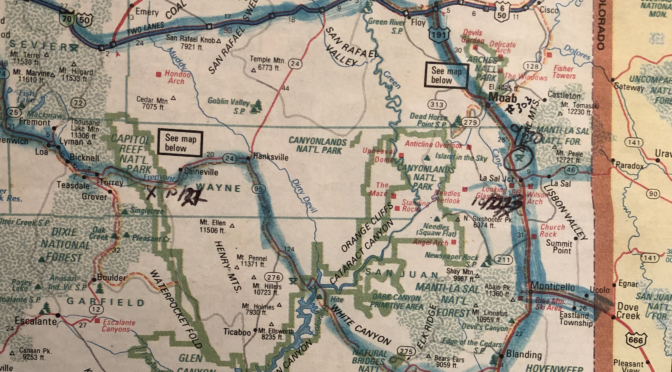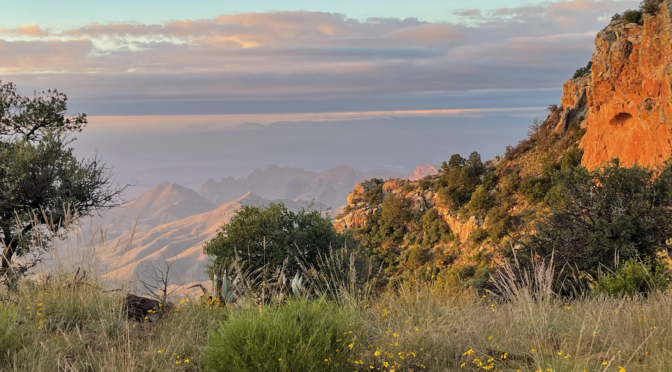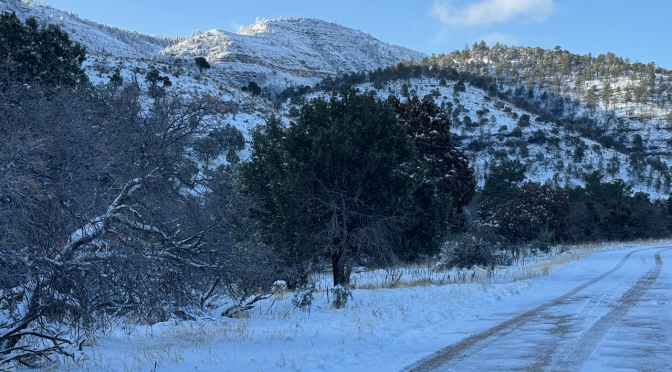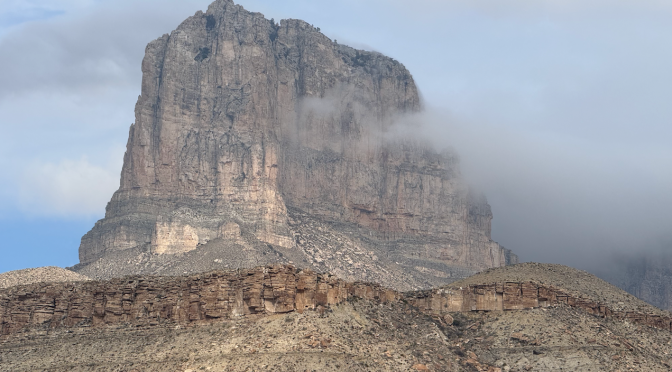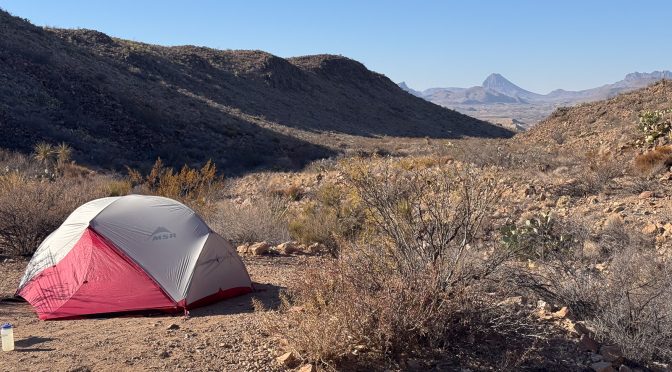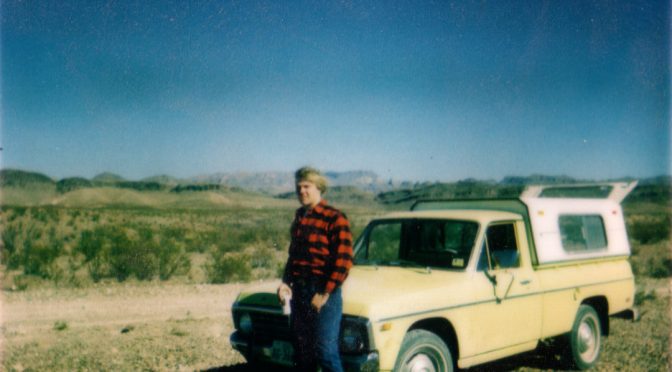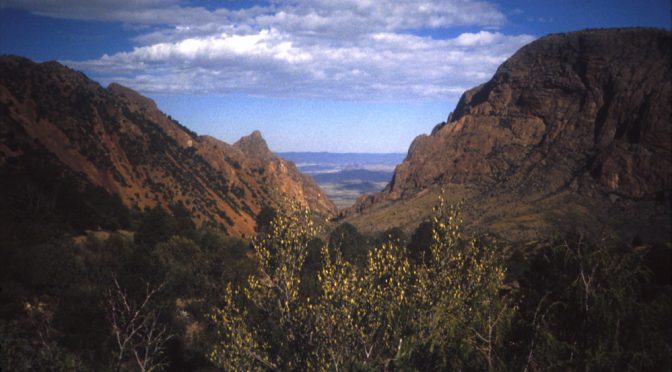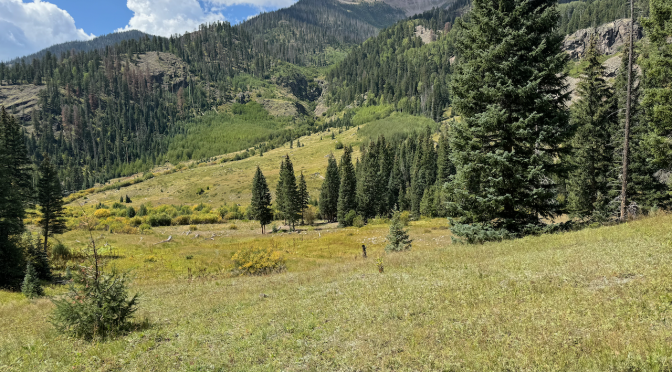| Year | Dates | Location | Activity | Post |
|---|---|---|---|---|
| 1968 | April/Easter | Big Bend NP | Camping, Hiking | TR-Big Bend NP Family Trip April 1968 |
| 1977 | December | Big Bend NP | Camping, Hiking | TR-Big Bend NP December, 1977 |
| 1985 | April | Big Bend NP | Camping, hiking | TR-Big Bend NP-April 1985 |
| 1985 | April | Guadalupe Mountains NP | Camping, Hiking | TR-Guadalupe Mountains April, 1985 |
| 1986 | October | Guadalupe Mountains NP | Backpacking | TR-Guadalupe Mountains NP Backpacking Oct 1986 |
| 1986 | September | Guadalupe Mountains NP | Backpacking | TR-Guadalupe Mountains NP Backpack Sept 1986 |
| 1997 | August | Guadalupe Mountains NP | Hiking | TR-Guadalupe Peak 1997 |
| 1997 | August | Wheeler Peak Wilderness (New Mexico) | Hiking | TR-Wheeler Peak-New Mexico Highpoint 8/31/97 |
| 1999 | February | Big Bend NP | Backpacking | TR-Big Bend NP Backpack South Rim Feb/March 1999 |
| 2000 | February | Guadalupe Mountains NP | Backpacking | TR-Guadalupe Peak February 2000 |
| 2000 | August | Indian Peaks Wildeness | Backpacking | TR-Indian Peaks Wilderness August 24-25, 2000 |
| 2002 | August | John Muir Trail | Backpacking | John Muir Trail Thru-hike 2002 |
| 2003 | August | Humphrey Peak (Arizona) | Hiking | Arizona Highpoint-Humphreys Peak 8/13/03 |
| 2008 | Indian Peaks Wilderness | Backpacking | TR-Indian Peaks 2008 Backpacking | |
| 2011 | January | Grand Canyon NP | Camping | TR-Grand Canyon camping January 2011 |
| 2011 | January | Grand Canyon NP | Backpacking | TR-Grand Canyon Backpacking January 2011 |
| 2014 | November | Big Bend NP | Camping | Big Bend Camping November 2014 |
| 2014 | April May | Texas, New Mexico, Utah | Camping, Hiking, Travel | Trip to New Mexico |
| 2017 | November | Guadalupe Mountains NP | Backpacking | TR-Backpack-GUMO Shumard 11/16/2017 |
| 2019 | November | Guadalupe Mountains NP | Camping, Hking | TR-Guadalupe Mountains Dog Canyon & Gypsum Dunes November 14-16, 2019 |
| 2022 | February | Guadalupe Mountains NP | Backpacking, Camping, Hiking | TR-GUMO Pine Springs/Guad. Peak; Dog Canyon/Marcus backpack-February 2022 |
| 2022 | October | Big Bend NP | Camping, Backpacking | TR-BBNP Backpack Northeast Rim (and more)-October 2022 |
| 2024 | September | Weminuche Wilderness | Backpacking, Camping, travel | TR-Backpack-Colorado-Weminuche-September 2024 |
| 2024 | December | Guadalupe Mountains NP | Camping, Hiking | TR-Guadalupe Mountains NP camping-December 2024 |
| 2025 | January | Big Bend NP, Big Bend Ranch SP | Camping | TR- BBNP, BBRSP (partially canceled)-January 2025 |
| 2025 | April | Guadalupe Mountains NP | Camping, Hiking, Backpacking | TR-Guadalupe Mountains National Park camping and (canceled) backpacking-April 2025 |
Category Archives: Admin
TR-BBNP Backpack Northeast Rim (and more)-October 2022
One night Seminole Canyon State Park; in Big Bend National Park two nights Cottonwood Campground, one night backpack to NE4, two nights Paint Gap 4
- Seminole Canyon State Park: Camping 10/15/22
- Big Bend National Park
- Camping: Cottonwood Campground BBNP 10/16/22–10/17/22
- Backpack East Rim 4: 10/18/22
- Camping: Paint Gap 4 10/19/22–10/21/22 | Flickr album
One characteristic of aging is that you can get great pleasure from revisiting experiences of your youth. Separated by decades, you forget the details of such experiences but recall that you enjoyed them immensely. In my case this holds true not only for books but also for my outdoor experiences. Going back decades later over trails previously trodden can be as full of joy and discovery as it had been the first time.
With this in mind I wanted to do an overnight to the South Rim, including the East Rim (which I don’t believe I’d been on before). I took advantage of online camping reservation systems and I booked a trip for October 15–21, starting with Seminole Canyon State Park and ending with three days at Paint Gap 4, probably my favorite primitive site in Big Bend National Park. In between was an overnight to ER4 (East Rim #4), a backcountry site on the Rim in the Chisos Mountains. My last backpack in the Chisos had been, I think, 1999. My last trip to the South Rim had been a day hike with friends in January of 2009, and I don’t know that I’d ever been to the east rim side as it’s seasonally closed for the Peregrine Falcon. (My first South Rim hike had been as a nine-year-old with my family in 1968.)
Continue reading TR-BBNP Backpack Northeast Rim (and more)-October 2022TR-Guadalupe Mountains National Park camping and (canceled) backpacking-April 2025
Camping and backpacking at Dog Canyon campground; heavy snow made the backpacking impossible
- Camping: April 2-7 | Flickr album (and more videos)
Gear, Lessons learned
Trip Report
Planning
This trip was supposed to go something like this: camp at Dog Canyon campground in Guadalupe Mountains National Park (GUMO) then a long day hike followed by a rest and packing day, then an overnight backpack to Blue Ridge backcountry site, one of only 3 I haven’t backpacked to yet. Another goal was to hike the Marcus trail and the far northwestern section of the Bush Mountain trail, neither which I’d ever done. I had five days at Dog Canyon CG reserved and a backcountry permit for Blue Ridge on Saturday night, April 5.
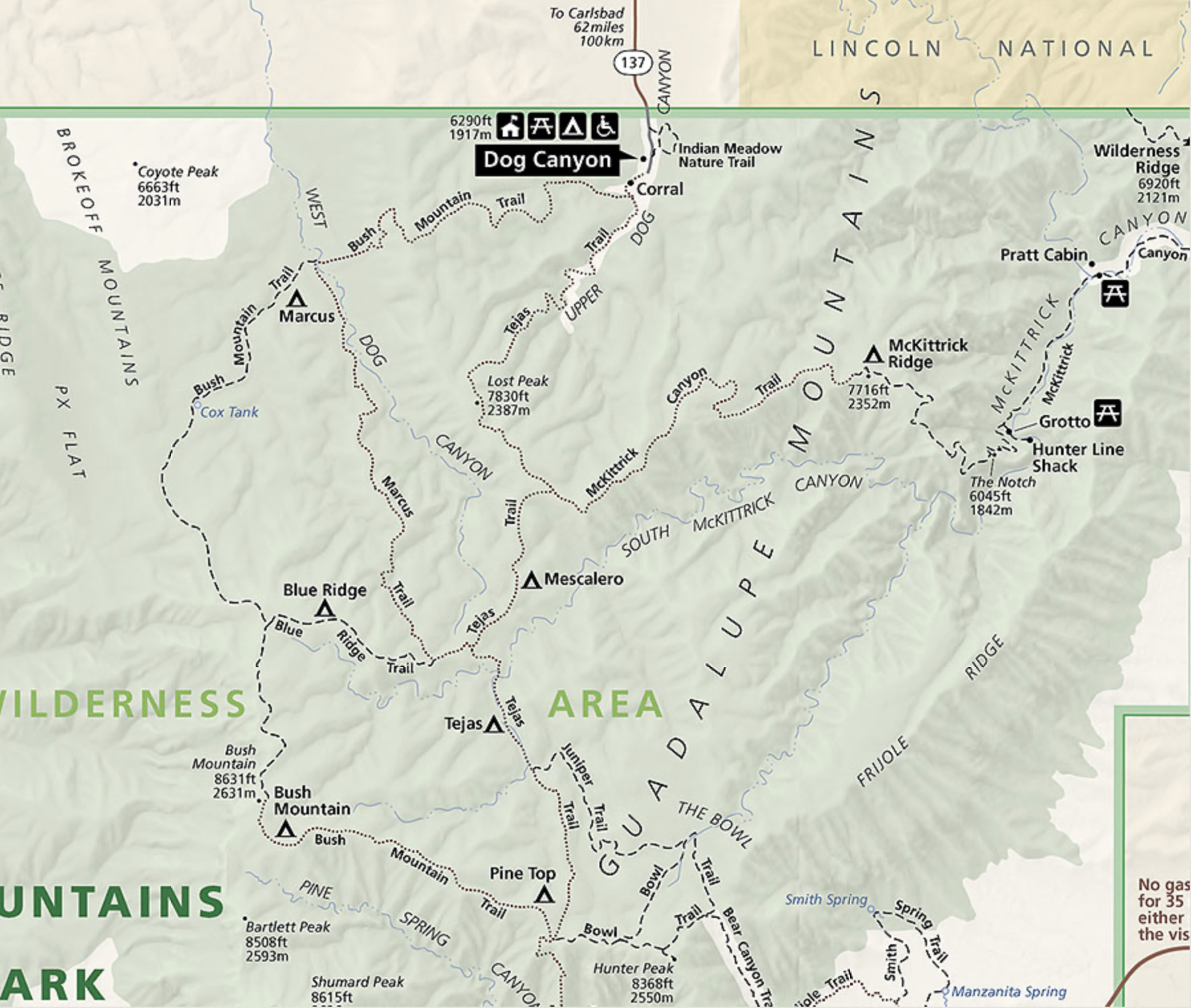
TR-Guadalupe Mountains NP camping-December 2024
- Guadalupe Mountains National Park 12/2/24-12/5/24
- Guadalupe Peak horse trail 12/2/24
- Frijole-Smith Springs loop 12/3/24
- Tejas Trail -> Trail jct. 12/4/24
Gear, Lessons learned
Trip Report
Continue reading TR-Guadalupe Mountains NP camping-December 2024TR- BBNP, BBRSP (partially canceled)-January 2025
This was planned for a couple of days a Paint Gap 3, then on to Big Bend Ranch State Park/Fresno Vista, for three more days.
Gear
Trip Report
Not much to report here; I’d booked two nights at Paint Gap 3 (formerly Paint Gap 4, note the name change) to be followed by three more over at Fresno Vista in Big Bend Ranch State Park. I’ve stayed at both of these spots many times.
So things on this trip didn’t end up as planned, in many ways. But that’s o.k.–what’s the saying, “a bad night in the backcountry is better than a good day at work”? Yeah, I know that’s not it but whatever.
Things started roughly, out of Austin. As I was checking the air in my tires before departing I discovered a sheet metal screw in the tire. I went down the street to a local shop and got it repaired quickly. Fortunately it wasn’t too close to the sidewall.
Continue reading TR- BBNP, BBRSP (partially canceled)-January 2025TR-Big Bend NP December, 1977
A trip to Big Bend National Park with a high school friend back in my teenage days
Gear, Lessons learned
Trip Report
Planning
In late 1977–probably during semester break in December–my high school friend and baseball teammate Kelly and I took a camping trip to Big Bend National Park. I write this almost fifty years after the trip; I have no notes, just some foggy recollections, a handful of Polaroid prints, and possibly a roll of 35mm film somewhere around here that hasn’t yet been digitized.
We’d done some winter camping on some property owned by some friends’ of Kelly’s family. I wouldn’t say we became expert campers, but we learned some things; how to manage all the Coleman fueled items (stove, lanterns), how to pitch my ancient, huge Sears canvas tent, how to stay reasonably warm.
It would be my second trip to BBNP, and I was itching to return.
TR-Big Bend NP-April 1985
First solo trip west; Big Bend National Park, Guadalupe Mountains National Park, Carlsbad Caverns National Park, Lubbock
- 4/18/85-4/21/85 Big Bend NP
- 4/18 Depart Austin 12: 25 a.m.
- 4/18 Arrive BBNP ca. noon.
- 4/18 Lost Mine Peak trail
- 4/19-Chimneys trail
- 4/20-Emory Peak summit
- 4/21-Window trail, Hot Springs
- 4/21-4/24 Guadalupe Mountains NP (separate post)
A note about some of the photos here–I scanned many of these slides thirty years ago when I had to squeeze them onto floppy disks, so their resolution is poor.
Gear, Lessons learned
Trip Report
Planning
Some of this is duplicated in the following post (Guadalupe Mountains)
I was twenty-six years old, still in the middle of my offshore oilfield career. I had read the old “Trails of the Guadalupes” guide, published by the Carlsbad Caverns Natural History Association, backwards and forwards while working on out in the Gulf of Mexico and had decided I needed to go see Guadalupe Mountains National Park (GUMO) and climb the highest mountain in Texas. But I also wanted to go back to the place I first fell in love with the desert mountains, Big Bend National Park. My last trip there had been when I was still a teenager with my friend Kelly, in 1977. I had also been reading, repeatedly, the Hikers Guide to Trails of Big Bend National Park. I was working offshore at this time, but had a week off and that may explain my odd departure times.
Continue reading TR-Big Bend NP-April 1985TR-Backpack-Colorado-Weminuche-September 2024
Backpacking in Weminuche Wilderness, then AirBnB in Cortez, CO
Gear, Lessons learned
Trip Report
Planning
I decided I wanted to revisit a couple of backpacking trips I’d made years ago, partly because a lot of my earlier trip had been obscured by clouds and fog, and partly just to get out to a not too crowded part of the San Juans again. I would visit an area where I’d camped and backpacked going back almost forty years, the San Juan mountains and the Weminuche Wilderness. I first visited the San Juans on a long trip in 1986, car camping at Vallecito campground on the western side of the wilderness area, based on a suggestion from my parents. I returned for a couple of backpacking trips in the 1990s, in the Williams Creek area which is about thirty miles north of Pagosa Springs on USFS roads.
Continue reading TR-Backpack-Colorado-Weminuche-September 2024